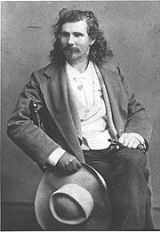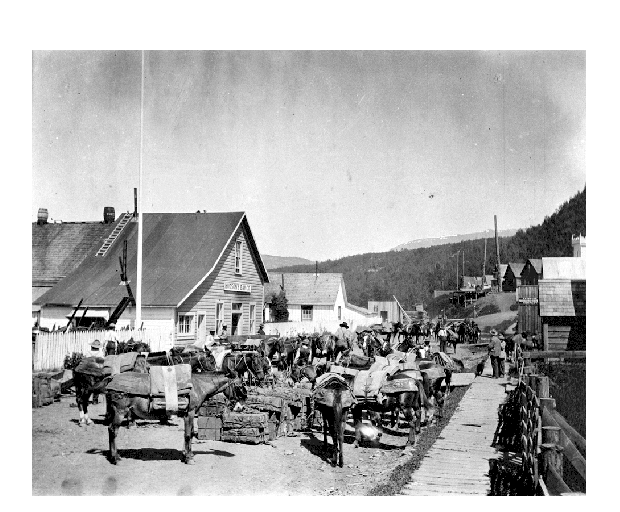
Cataline
Encyclopedia

Moving company
A moving company, removalist, or van line is a company that helps people and businesses relocate their goods from one place to another. Typically they use moving vans, but for international moves or where storage is required, they may use special containerised vans or shipping containers.National...
of the Canadian West.
Biography
In different biographies Cataline has been recorded as being born in Mexico, Spain and France. Other biographies like the one written by Sperry ClineSperry Cline
Sperry Cline, DCM was a frontier policeman and author in British Columbia, Canada.-Early life:Cline was born near St. Thomas, Ontario in the early 1880s. In his teens, he traveled to England and joined the British South Africa Company's cavalry...
, who knew Cataline personally, say he was born at Oloron-Sainte-Marie
Oloron-Sainte-Marie
Oloron-Sainte-Marie is a commune in the Pyrénées-Atlantiques department in south-western France. The town of Oloron-Sante-Marie is positioned at the junction of two rivers and has a population of approximately 12,000. While not spectacular, it is a pleasant looking town, with an ancient quarter,...
in Béarn
Béarn
Béarn is one of the traditional provinces of France, located in the Pyrenees mountains and in the plain at their feet, in southwest France. Along with the three Basque provinces of Soule, Lower Navarre, and Labourd, the principality of Bidache, as well as small parts of Gascony, it forms in the...
, a kingdom of France, near the Spanish border. Most accounts agree on his year of birth as 1832.
Although the exact date of his arrival in British Columbia
British Columbia
British Columbia is the westernmost of Canada's provinces and is known for its natural beauty, as reflected in its Latin motto, Splendor sine occasu . Its name was chosen by Queen Victoria in 1858...
is unknown, it is recorded that he was packing at the beginning of the Fraser Canyon Gold Rush
Fraser Canyon Gold Rush
The Fraser Canyon Gold Rush, began in 1858 after gold was discovered on the Thompson River in British Columbia at its confluence with the Nicoamen River. This was a few miles upstream from the Thompson's confluence with the Fraser River at present-day Lytton...
in 1858 and continued until 1912, a span of 54 years. He wore the same type of clothing year round: a boiled white shirt, heavy woolen pants, riding boots and no socks. When he had business to conduct, he added a collar, tie and a French hat to his apparel. On every trip he brought along a chair made of birch and rawride where he would sit as he negotiated his business, while everyone else sat on the ground. Though illiterate, he had an excellent memory and kept his business records in his head without ever making a single note. Even though he used over sixty mules, he knew to the item what each of them carried, where they were being delivered to and what he had to charge. And although he ran mule trains for over half a century he never lost a pound of cargo, except in one instance when his secundo upon smelling a two pound package of Limburger Cheese decided it was rotten and threw it away. Once aware of the error, Cataline made sure it was replaced and delivered. One of the best stories about him involves a loan that he had to make after a fatal disease had killed several of his mules. The bank manager questioned Cataline's collateral, wondering how many mules and horses he owned before consenting to lend him the money. When Cataline returned to the bank in the fall to repay the debt, he counted out the exact amount owing and paid it in full. The bank manager noted that Cataline had more money on his person and suggested that he deposit it in the bank. Cataline responded with a query as to how many horses and mules the bank owned, and upon learning it was none, decided to keep his money.
The Pack Trains
Cataline's pack train usually consisted of sixty mules. The pack mules could carry 250 - 300 pounds and could navigate very difficult trails. Cataline's mules were so well trained that when the corregidor rang a signal bell, they would go to their own packs and wait to be loaded. Each outfit also employed six or more men, a foreman, also known as a corregidor, a second man, known as a secundo, a cook and several muleteers. In Cataline's outfit, his corregidor was Ah Gun and his secundo was Dave Wiggins.The early years
Cataline packed from YaleYale, British Columbia
Yale is an unincorporated town in the Canadian province of British Columbia. It was founded in 1848 by the Hudson's Bay Company as Fort Yale by Ovid Allard, the appointed manager of the new post, who named it after his superior, James Murray Yale, then Chief Factor of the Columbia District...
to Barkerville during the Cariboo Gold Rush
Cariboo Gold Rush
The Cariboo Gold Rush was a gold rush in the Canadian province of British Columbia. Although the first gold discovery was made in 1859 at Horsefly Creek, followed by more strikes at Keithley Creek and Antler Horns lake in 1860, the actual rush did not begin until 1861, when these discoveries were...
. He married a Thompson Indian woman from the Spuzzum Band.
After the CPR
Then with the completion of the Canadian Pacific RailwayCanadian Pacific Railway
The Canadian Pacific Railway , formerly also known as CP Rail between 1968 and 1996, is a historic Canadian Class I railway founded in 1881 and now operated by Canadian Pacific Railway Limited, which began operations as legal owner in a corporate restructuring in 2001...
, he moved his headquarters to Ashcroft
Ashcroft
Ashcroft is a surname.Ashcroft may also refer to:*Ashcroft, Gloucestershire, England, which is the namesake of:**Ashcroft, British Columbia, a village in Canada*Ashcroft, New South Wales, a suburb of Sydney, Australia...
. His wife remained in Spuzzum, but he continued to support her, always in the form of $20 gold coins. During this period, he was friends with Judge Matthew Baillie Begbie
Matthew Baillie Begbie
Sir Matthew Baillie Begbie was born on the island of Mauritius, thereafter raised and educated in the United Kingdom...
, who once held an impromptu court to provide Cataline with Canadian citizenship when his squatting rights were questioned. In 1897, Cataline led a pack train all the way from Ashcroft, then the southern terminus of the Cariboo Road
Cariboo Road
The Cariboo Road was a project initiated in 1860 by the colonial Governor of British Columbia, James Douglas...
, all the way to the Yukon Territory.
Quesnel and Hazelton

Grand Trunk Pacific Railway
The Grand Trunk Pacific Railway was a historical Canadian railway.A wholly owned subsidiary of the Grand Trunk Railway , the GTPR was constructed by GTR using loans provided by the Government of Canada. The company was formed in 1903 with a mandate to build west from Winnipeg, Manitoba to the...
was announced, Cataline moved his operations to Quesnel
Quesnel, British Columbia
-Demographics:Quesnel had a population of 9,326 people in 2006, which was a decrease of 7.1% from the 2001 census count. The median household income in 2005 for Quesnel was $54,044, which is slightly above the British Columbia provincial average of $52,709....
to better serve the booming Central Interior. He packed throughout the Cariboo, Central Interior and Skeena River district until 1912 when he retired in Hazelton
Hazelton, British Columbia
Hazelton is a small town located at the junction of the Bulkley and Skeena Rivers in northern British Columbia, Canada. It was founded in 1866 and has a population of 293...
.
In 1920 he decided to spend his remaining winters in Victoria
Victoria, British Columbia
Victoria is the capital city of British Columbia, Canada and is located on the southern tip of Vancouver Island off Canada's Pacific coast. The city has a population of about 78,000 within the metropolitan area of Greater Victoria, which has a population of 360,063, the 15th most populous Canadian...
, but after spending just one winter in the Dominion Hotel, he returned to Hazelton for the rest of his days. He died in October 1922 at the age of 90 and is buried in the Hazelton cemetery. A brass plaque on his cairn simply reads 'Jean Caux - Cataline, the packer.
Places Named After Cataline
- Cataline Elementary School in Williams Lake, British ColumbiaWilliams Lake, British ColumbiaWilliams Lake, is a city in the Central Interior of British Columbia, Canada. Located in the central part of a region known as the Cariboo, it is the largest urban centre between Kamloops and Prince George, with a population of 11,150 in city limits....
- Cataline Creek in the Kispiox region near Hazelton http://srmwww.gov.bc.ca/bcgn-bin/bcg10?name=3414
Cataline in Books and Movies
- The Legend of Cataline (a film by Red Letter Films
- Cataline from Pioneer Days in British Columbia Volume 1 Article 20, Sperry Cline, Art Downs editor. ISBN Unknown
- Jean Caux 'The Man they called Cataline from Frontier Days in British Columbia
- The Far Land, Eva MacLean ISBN 0-920576-41-91
- Heritage of Canada ISBN 0-88850-065-3

